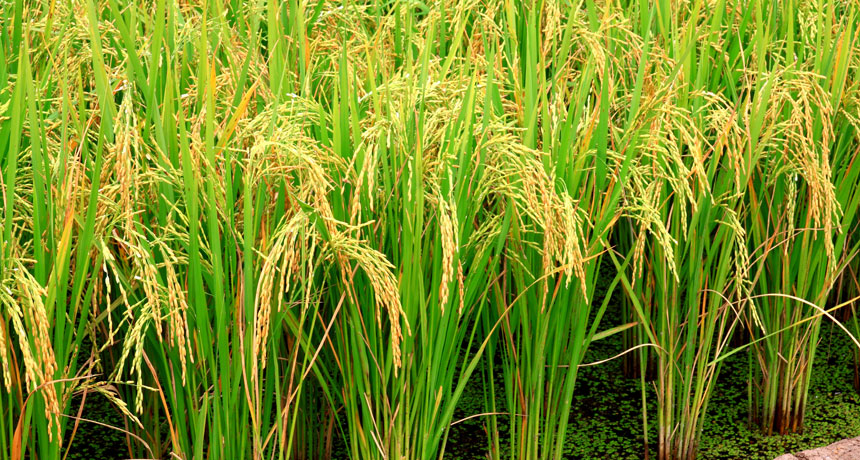Enzymes aid rice plants’ arsenic defenses

BOSTON — Rooted in place, plants can’t run away from arsenic-tainted soil — but they’re far from helpless. Scientists have identified enzymes that help rice plant roots tame arsenic, converting it into a form that can be pushed back into the soil. That leaves less of the toxic element to spread into the plants’ grains, where it can pose a health risk to humans, researchers reported February 17 at the annual meeting of the American Association for the Advancement of Science.
Once arsenic worms its way into rice plant roots and gets into the vascular system, “it’s transported into the leaves and the grain,” David Salt, a biologist at the University of Nottingham in England who conducted the recent research, said during a news conference. Inside the plant, arsenic “can accumulate to levels where it can potentially be toxic if it accumulates over long times.”
Since arsenic occurs naturally in soil, understanding the genetic basis for plants’ natural defense mechanisms might help researchers engineer plants that take in less arsenic, said Mary Lou Guerinot, a biologist at Dartmouth College.
Arsenic in the soil switches between two different forms — ions with different electric charges. That form depends on soil conditions, which in a rice field fluctuate between wetter and drier. Plants are more likely to pull in arsenite from the soggy soil of a flooded rice paddy, and arsenate when that soil dries out a bit. The plants use different chemical mechanisms to take in and process the different arsenic ions.
In arsenate-rich soil, the ion sneaks into the outer layer of root cells through specialized passageways, called transport channels, that normally carry phosphate ions through root cell membranes. Transforming arsenate into arsenite lets the roots push the element back into the soil through a process called efflux, but scientists weren’t sure how the plant changed arsenic’s form.
Salt’s team found that rice plants without working genes for enzymes called HAC1;1 and HAC1;2 couldn’t turn arsenate into arsenite. So more arsenate accumulated in the plants’ shoots. When the scientists made HAC1;1 and HAC1;2 genes in other rice plants produce more of the enzymes than usual, grains from those plants had lower concentrations of any form of arsenic.
It’s just one defense of many, Salt said, and it’s not bulletproof. Arsenate can still spread into plants’ vascular systems from the roots via phosphate channels.
When the soil is rich in arsenite, rice roots take arsenite up through the same channels that take in silicon. Although efflux is an efficient way for roots to get rid of arsenite, there’s a limit to how quickly the cells can push the ion out.
So to create rice plants that are better at dealing with arsenic, Salt and other scientists are looking not just at how roots push out arsenic once it gets in, but how they keep the toxin out to begin with. For example, engineering channels that are better at pulling in just phosphate or just silicon could lessen the amount of arsenic that co-opts those channels.
Since soil conditions in a rice field switch between dry and wet, plants need defense mechanisms for both forms of arsenic. “Once we know what forms the plant takes in and how it’s doing that, we’ll need a solution for arsenate and arsenite,” Guerinot says. “There’s no easy fix.”